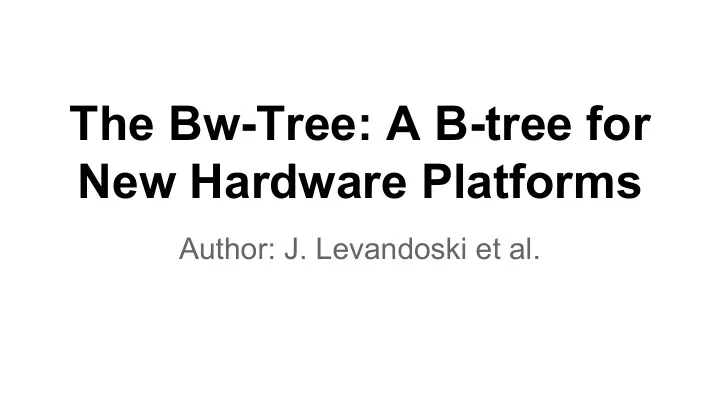

The Bw-Tree: A B-tree for New Hardware Platforms Author: J. Levandoski et al.
B uzz w ord The Bw-Tree: A B-tree for New Hardware Platforms DRAM + Flash storage Author: J. Levandoski et al.
Hardware Trends ● Multi-core + large main memories ○ Latch contention ■ Worker threads set latches for accessing data ○ Cache invalidation ■ Worker threads access data from different NUMA nodes
Hardware Trends ● Multi-core + large main memories ○ Latch contention ■ Worker threads set latches for accessing data ○ Cache invalidation ■ Worker threads access data from different NUMA nodes Delta updates ○ No updates in place ○ Reduces cache invalidation ○ Enable latch-free tree operation
Hardware Trends ● Flash storage ○ Good at random reads and sequential reads/writes ○ Bad at random writes ■ Erase cycle
Hardware Trends ● Flash storage ○ Good at random reads and sequential reads/writes ○ Bad at random writes ■ Erase cycle Log-structured storage design
Architecture ● CRUD API ● Bw-tree search logic Bw-tree Layer ● In-memory pages ● Logical page abstraction Cache Layer ● Paging between flash and RAM ● Sequential writes to log- Flash Layer structured storage ● Flash garbage collection
Architecture Atomic record store, not an ACID transactional database ● CRUD API ● Bw-tree search logic Bw-tree Layer ● In-memory pages ● Logical page abstraction Cache Layer ● Paging between flash and RAM ● Sequential writes to log- Flash Layer structured storage ● Flash garbage collection
Architecture Atomic record store, not an ACID transactional database ● CRUD API ● Bw-tree search logic Bw-tree Layer ● In-memory pages ● Logical page abstraction Cache Layer ● Paging between flash and RAM ● Sequential writes to log- Flash Layer structured storage ● Flash garbage collection
Logical Pages and Mapping Table ● Logical pages are identified by PIDs stored as Mapping Table keys. ● Physical addresses can be either in main memory or in flash storage.
Delta Updates ● Tree operations are atomic. ● Update operations are “logged” as a lineage of delta records. ● Delta records are incorporated to the base page asynchronously. ● Updates are “installed” to Mapping Table through compare-and-swap. ● Important enabler for latch-freedom and cache-efficiency.
Delta Updates Q: What is the performance of reading data from page P? ● Tree operations are atomic. ● Update operations are “logged” as a lineage of delta records. ● Delta records are incorporated to the base page asynchronously. ● Updates are “installed” to Mapping Table through compare-and-swap. ● Important enabler for latch-freedom and cache-efficiency.
Other details ● SMO: structure modification operations ○ split, merge, consolidate ○ has multiple phases -> how to make SMO atomic? ● In-memory page garbage collection ○ epoch-based.
Architecture ● CRUD API ● Bw-tree search logic Bw-tree Layer ● In-memory pages ● Logical page abstraction Cache Layer ● Paging between flash and RAM ● Sequential writes to log- Flash Layer structured storage ● Flash garbage collection
Flash Layer
Flushing Pages Q: Why flushing pages? Q: When to flush pages? Q: How many pages to flush? Q: What if you crash during a flush? Modify 40 to 60 PID Physical Address Delete 33 Insert 50 P Insert 40 Page P Log-structured Store
Flushing Pages PID Physical Address P Flush Write Buffer Page P Log-structured Store
Flushing Pages PID Physical Address P Flush Write Buffer Page P Page P Log-structured Store
Flushing Pages PID Physical Address P Flush Write Buffer Page P Page P Page T Log-structured Store
Flushing Pages PID Physical Address P Flush Flush Write Buffer Page P Log-structured Store Page P Page T
Flushing Pages PID Physical Address Delete 33 Insert 50 P Flush Flush Write Buffer Page P Log-structured Store Page P Page T
Flushing Pages PID Physical Address Delete 33 Insert 50 P Flush Flush Write Buffer Page P Log-structured Store Page P Page T
Flushing Pages PID Physical Address Delete 33 Insert 50 P Flush Flush Write Buffer Delete 33 Page P Insert 50 Log-structured Store Page P Page T
Flushing Pages PID Physical Address Delete 33 Insert 50 P Flush Flush Write Buffer Delete 33 Page E Page P Insert 50 Log-structured Store Page P Page T
Flushing Pages Flush PID Physical Address Delete 33 Insert 50 P Flush Flush Write Buffer Page P Log-structured Store Page P Page T Delete 33 Page E Insert 50
Other details ● Log-structured Store garbage collection ○ Cleans orphaned data unreachable from mapping table ○ Relocates entire pages in sequential blocks (to reduce fragmentation) ● Access method recovery ○ Occasionally checkpoint mapping table ○ Redo-scan starts from last checkpoint
Experiment ● Against ○ BerkeleyDB (without transaction) ○ latch-free skip-list
Experiment Over Skip-list: - 4.4x speedup in read-only workload. - 3.7x speedup in update-intensive workload. Over BerkerleyDB: - 18x speedup in read-intensive workload - 5-8x speedup in update-intensive workload
Thank you! Slides adapted from http://www.hpts.ws/papers/2013/bw-tree-hpts2013.pdf
Recommend
More recommend